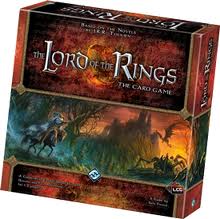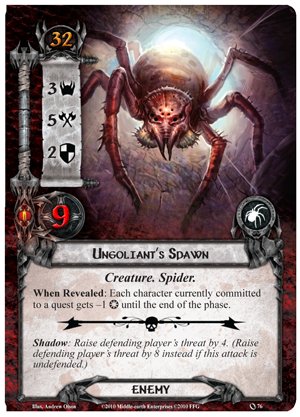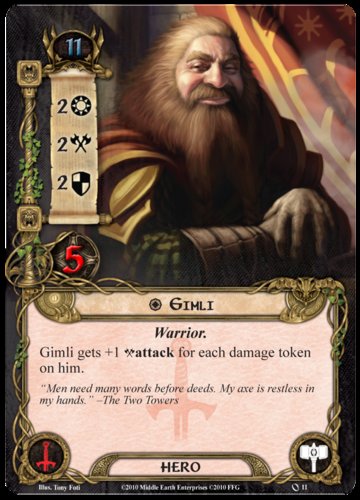The Lord of the Rings: The Card Game—A Review
/By Jeremiah
 Well, we've certainly done our share of gushing over this game, but we've never actually given it our full, in-depth review. Until now. If you've never played a living card game (LCG) before, know this: The rules are deep and complex, and they're very similar to a collectible card game (CCG)—the biggest difference between the two is market collectibility. A CCG is distributed through starter decks and booster packs that randomly give you the cards of a 200-300 card set. An LCG releases the complete set in an expansion, so you're not trying to buy pack after pack after pack to get that one awesome card. You know exactly what you're getting in every pack, and my pack is going be the same pack you get.
Well, we've certainly done our share of gushing over this game, but we've never actually given it our full, in-depth review. Until now. If you've never played a living card game (LCG) before, know this: The rules are deep and complex, and they're very similar to a collectible card game (CCG)—the biggest difference between the two is market collectibility. A CCG is distributed through starter decks and booster packs that randomly give you the cards of a 200-300 card set. An LCG releases the complete set in an expansion, so you're not trying to buy pack after pack after pack to get that one awesome card. You know exactly what you're getting in every pack, and my pack is going be the same pack you get.
The Lord of the Rings: The Card Game, which I will refer to as LOTR from here on out, delivers what everyone would want in a CCG, but puts it in a co-operative format. It's quite simply one of the funnest card games (LCG or CCG) I have ever put my hands on!
The Core set of the game includes a starter deck of 4 spheres of influence (you'll see more about that later), several sets of encounter cards, 3 quest decks, 2 threat counters and all the various tokens you will need (progress, wound and resource).
The game is designed for 2 players...or is it? With the purchase of a second core set you can expand to 4, and the design actually scales very well for anywhere from 1-4 players (yes, you can play a solo version!). Players each control three heroes which come from 4 different "spheres of influence" in Middle Earth: tactics, spirit, lore, and leadership. As with any LCG or CCG, deck customization plays a big part in terms of your success or failure. I won't go into the ins and outs of deckbuilding here. I will say that there is a group of 4-6 of us who play together, and we've all sort of taken ownership of our own sphere, and we all play with mono-sphere decks. It has its advantages and its disadvantages, but it's seemed to work for us for the time being.
Because the game is co-op the player turn is set up slightly differently than a standard card game. Instead of each player going through the different phases of a turn, completing their turn and then play moving on to the next player, players in turn walk through each phase of a turn or round. For instance, after the refresh phase in which players give each hero a resource token (money) and draw a card and pass the "first player" marker to the left, players start the planning phase. Whoever was just passed the first player marker now plays cards from their hand, paying the appropriate resources to do so. These are typically items or allies to add to your party. But instead of moving on to the quest phase, the next player then performs their planning phase, and so on. During each phase players are encouraged to discuss their strategies and what they are doing, making it one big team effort. You're not supposed to reveal exactly which card you're holding in your hand but you can definitely talk about the abilities that card will give you, or your teammates.
So we're all in this together...well then what are we up against? Aside from each players' deck, there are two other decks involved in the game. A quest deck, and an encounter deck.
 The Encounter Deck—It's full of baddies, locations, and other stuff that you will have to encounter during the game. Defeating enemies is not how you win the game, but they can certainly be the reason you lose the game! Traveling to locations can earn you certain bonuses or penalties depending on where you are going.
The Encounter Deck—It's full of baddies, locations, and other stuff that you will have to encounter during the game. Defeating enemies is not how you win the game, but they can certainly be the reason you lose the game! Traveling to locations can earn you certain bonuses or penalties depending on where you are going.
The Quest Deck—This deck is usually only 3 cards, though sometimes more and sometimes less. It tells you how you win the game, and sometimes gives you alternative loss conditions as well. It also tells you which cards go into the encounter deck, which often gives you a clue as to how hard, or what type of quest, it's going to be.
Typically to successfully complete a quest you have to place an amount of progress tokens on the currently active card of the quest deck. And often fulfill some other condition. So... How does one place a progress token on the quest deck? I'm glad you asked.
The two most crucial phases of the game are the quest phase and the encounter phase.
The Quest Phase—Players must decide whether to commit their heroes and allies to the quest; if they do, they exhaust that character, and turn the card on its side (just like tapping in Magic The Gathering). This means that the character cannot attack or defend any baddies coming out until the next turn. But their "will" is committed to the quest and cancels out an equivalent amount of threat in the staging area (which is where the bad guys live after they come out of the encounter deck, and before they attack). After the last player has committed characters to the quest, out comes one encounter card per player in the game. Each of these cards have a threat level on them which adds to the threat in the staging area. AFTER these cards are revealed, if the total amount of committed will is greater than the threat, then players place progress tokens on the quest (or active location they have traveled to) in the amount of the difference. If not, then each player increases their threat level by the difference on their threat counters. (Hitting 50 on your counter signifies the end of the game for you!) Okay, take a breath. Still with me? Good.
 The Encounter Phase—Things get hairier in the encounter phase. Players can choose to engage any of the bad guys in the staging area, or let them engage you later. It's often helpful if someone is primed for fighting to have them engage a tougher opponent so they don't beat on your friend who isn't ready to face such a battle. Each decision piles up on the next, because there are mechanisms in place that will cause enemies to engage players based on your threat counter. And, if you have all of your characters committed to the quest, you're taking damage points that get turned into even more increases on your threat level. Things can snowball really, really quickly.
The Encounter Phase—Things get hairier in the encounter phase. Players can choose to engage any of the bad guys in the staging area, or let them engage you later. It's often helpful if someone is primed for fighting to have them engage a tougher opponent so they don't beat on your friend who isn't ready to face such a battle. Each decision piles up on the next, because there are mechanisms in place that will cause enemies to engage players based on your threat counter. And, if you have all of your characters committed to the quest, you're taking damage points that get turned into even more increases on your threat level. Things can snowball really, really quickly.
That, believe it or not, is a very rough overview of the game play. I told you. It's deep, complicated, and meticulous. But it is so fun!
This is not a casual party game; it's not even for the casual gamer—every decision, every card played, choosing whether to commit, to defend, to attack, everything, can make or break the success of the quest.
The storyline continues through the release of Adventure Packs, each of which includes a quest deck, usually a set of encounter cards, some new player cards to continue spicing up your deck, and setup instructions (often using several encounter sets from the core set). I love this aspect of it; it's like playing an RPG without having one person specified as the game master who has to put in hours of prep time before everyone else gets to play. For $15 you get a new quest and can have yourself a great evening. The down side is that rarely after we beat a quest do we go back and play it again. (Although there are plenty of them that took us more than one attempt!) And because of the monthly pace that Fantasy Flight maintains in releasing these packs, I'm a good $100+ behind in my chapter packs!
Final thoughts and my rating—I was introduced to "gaming through a couple different CCG-type games, so this title hits home for me. And it provides many nice twists to what is usually a head-to-head genre. The game is complex, but that complexity gives it a platform to build and expand on continuously, and also gives great great depth to the gameplay. The cards all have great synergy, not only within each sphere, but cross-sphere, making each quest a true team effort, which is something I've come to really enjoy about the game. And the Tolkien theme is icing on the cake. I give this one a 10.
Thanks so much for reading, and don’t forget to like us on Facebook, and follow us on Twitter!













